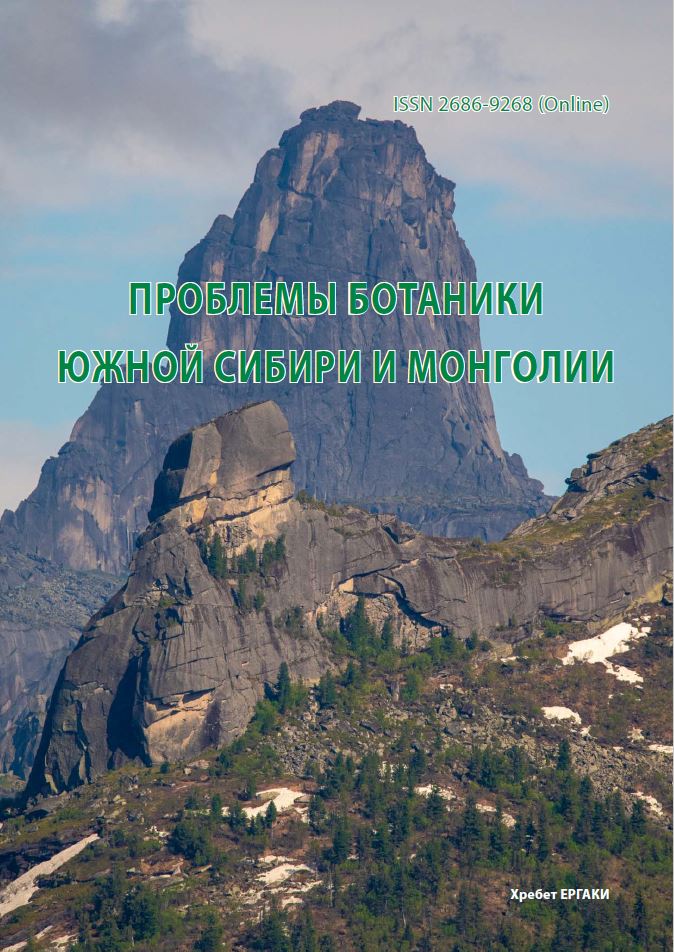Variety of forms of phytoliths of Kulunda soils and their phytocenotic affiliation
УДК 581.192.1+581.55(1-925.117)(571.150)
Abstract
Phytoliths are an important component of soil and vegetation cover. Thanks to phytolith analysis, it is possible to identify vegetation cover after a long time. There is practically no information about the transition of amorphous silica in the form of phytoliths from plant mass to soil. This very important stage in the formation of the soil phytolith spectrum was considered in the works of N. K. Kiseleva. When studying the phytolith spectra of dominant grasses and sedges, she calculated the coefficient of their participation for the Mongolian steppes, and further she proposed the concept of “phytolith spectrum" In this work, we made an attempt to assess the correlation of the set of phytolith forms and their ratio in the upper soil layer with the modern composition of vegetation. For this purpose, the phytolith spectra of soils and vegetation of three ecosystems were analyzed, and the phytolith spectra of modern soils were compared. We also applied the approach of Nina Kiseleva and the results we obtained of taxonomic diagnosis of plant species based on the forms of their phytoliths. The research was carried out on the territory of the North Kulunda lacustrine-alluvial plain. The phytolith complex of the surface layer of soils of the forb-fescue with wormwood steppe is characterized by the predominance of two groups of phytoliths: truncated cone-shaped (RONDEL) phytoliths and trapezoidal wavy plates (CRENATE). In the soils of the bushy feather-grass-forb steppe and solonetzic steppe with a cereal-licorice community, trapezoidal polylobed plates (CRENATE) and bilobed particles (BILOBATE) are added to them. Other indicator forms are presented in small quantities. Calculation of the soil phytolith complex allows one to diagnose the coenotic composition of cereals of the phytolith spectrum.
Downloads
Metrics
References
Бобров А. А., Хилимонюк И. З., Чемеровская Е. К. Аккумуляция биогенного кремнезема в разновозрастных почвах южной тайги // Почвоведение, 1991. - № 8. - С. 137-142.
Гольева А. А. Фитолиты и их информационная роль в изучении природных и археологических объектов. -Москва-Сыктывкар-Элиста: Полтекс, 2001. - 140 с.
Гаврилов Д. А. Транслокация фитолитов в почве // Проблемы ботаники Южной Сибири и Монголии, 2018. -Т. 17. - С. 281-285.
Гаврилов Д. А., Гольева А. А. Микробиоморфное исследование почв со вторым гумусовым горизонтом южно-таежной подзоны Западной Сибири // Вестник Томского гос. ун-та. Биология, 2014. - № 2 (26). - С. 5-22.
Динесман Л. Г., Киселева Н. К., Князев А. В. История степных экосистем Монгольской Народной Республики. - М.: Наука, 1989. - 213 с.
Классификация и диагностика почв России / Авторы и сост.: Л. Л. Шишов, В. Д. Тонконогов, И. И. Лебедева, М. И. Герасимова. - Смоленск: Ойкумена, 2004. - 342 с.
Киселева Н. К. Изучение фитолитов в почвах для выяснения истории растительности степей восточной Монголии // Известия Академии наук СССР. Серия географическая, 1982. - Т. 2. - С. 95-106.
Киселева Н. К., Князев А. В. Опыт применения фитолитного анализа для выявления географической и вековой изменчивости питания животных // Проблемы изучения современных биогеоценозов. - М.: Наука, 1984. -С. 29-63.
Лада Н. Ю., Гаврилов Д. А. Анализ фитолитного состава основных растений степных экосистем Западной Сибири // Вестник Томского государственного университета. Биология, 2016. - № 2 (34). - C. 53-68. DOI: 10.17223/19988591/34/4
Лада Н. Ю., Смоленцев Б. А. Фитолитный анализ генезиса стратозема светлогумусового (на примере приозерной территории озера Баган) // Вестник Томского государственного университета. Биология, 2015. - № 1 (29). -С. 16-27. DOI: 10.17223/19988591/29/2
Сперанская Н. Ю., Соломонова М. Ю., Силантьева М. М. Трихомы и лопастные фитолиты растений как возможные индикаторы мезофильных сообществ при реконструкции растительности // Приволжский научный вестник, 2013. - № 11(27). - С. 40-46.
Сперанская Н. Ю., Соломонова М. Ю., Чекменева Е. Н. Фитолиты растений в фитолитных спектрах луговых фитоценозов Северного Алтая // Проблемы ботаники Южной Сибири и Монголии, 2019. - Т. 18. - С. 408-411. DOI: 10.14258/pbssm.2019083
Угланов И. Н. Мелиорируемая толща почв и пород юга Западной Сибири. - Новосибирск: Наука, Сиб. отд-ние, 1981. - 193 с.
Чекменева Е. Н, Сперанская Н. Ю. Фитолиты растений в фитолитных спектрах лесных фитоценозов Северного Алтая // Ломоносовские чтения на Алтае: фундаментальные проблемы науки и техники: Сб. науч. статей междунар. конф. - Барнаул: Изд-во АлтГУ, 2018. - С. 1226-1229.
Madella M., Alexandre A., Ball T. Internetional Code for Phytolith Nomenclature 1.0 // Annals of Botany, 2005. -Vol. 96. - P. 253-260. DOI: 10.1093/aob/mci172
Neumann K., Stromberg C. A. E., Ball T., Albert R. M., Vrydaghs L., Cummings L. S. International code for phytolith nomenclature (ICPN) 2.0 // Annals of Botany, 2019. - Vol. 124 (2). - P. 189-199. DOI: 1093/aob/mcz064
Twiss P. C., Suess E., Smith R. Morphological classification of grass phytoliths // Reprinted from the Soil Science Society of America Proceedings, 1969. - Vol. 33, No. 1. - P. 109-117.



